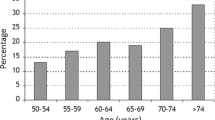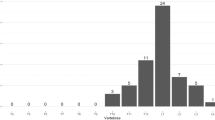Abstract
Summary
In the first population-based study of vertebral fractures in Latin America, we found a 11.18 (95% CI 9.23–13.4) prevalence of radiographically ascertained vertebral fractures in a random sample of 1,922 women from cities within five different countries. These figures are similar to findings from studies in Beijing, China, some regions of Europe, and slightly lower than those found in the USA using the same standardized methodology.
Introduction
We report the first study of radiographic vertebral fractures in Latin America.
Methods
An age-stratified random sample of 1,922 women aged 50 years and older from Argentina, Brazil, Colombia, Mexico, and Puerto Rico were included. In all cases a standardized questionnaire and lateral X-rays of the lumbar and thoracic spine were obtained after informed consent.
Results
A standardized prevalence of 11.18 (95% CI 9.23–13.4) was found. The prevalence was similar in all five countries, increasing from 6.9% (95% CI 4.6–9.1) in women aged 50–59 years to 27.8% (95% CI 23.1–32.4) in those 80 years and older (p for trend < 0.001). Among different risk factors, self-reported height loss OR = 1.63 (95% CI: 1.18–2.25), and previous history of fracture OR = 1.52 (95% CI: 1.14–2.03) were significantly (p < 0.003 and p < 0.04 respectably) associated with the presence of radiographic vertebral fractures in the multivariate analysis. In the bivariate analyses HRT was associated with a 35% lower risk OR = 0.65 (95% CI: 0.46–0.93) and physical activity with a 27% lower risk of having a vertebral fracture OR = 0.73 (95% CI: 0.55–0.98), but were not statistically significant in multivariate analyses
Conclusion
We conclude that radiographically ascertained vertebral fractures are common in Latin America. Health authorities in the region should be aware and consider implementing measures to prevent vertebral fractures.
Similar content being viewed by others
References
Clark P, Lavielle P, Franco-Marina F et al (2005) Incidence rates and life-time risk of hip fractures in Mexicans over 50 years of age: a population-based study. Osteoporos Int 16:2025–2030
Morosano M, Masoni A, Sanchez A (2005) Incidence of hip fractures in the city of Rosario, Argentina. Osteoporos Int 16:1339–1344
Morales-Torres J, Gutierrez-Urena S, Rheumatology OCoP-ALoAf (2004) The burden of osteoporosis in Latin America. Osteoporos Int 15:625–632
O’Neill TW, Felsenberg D, Varlow J, Cooper C, Kanis JA, Silman AJ (1996) The prevalence of vertebral deformity in European men and women: the European Vertebral Osteoporosis Study. J Bone Miner Res 11:1010–1018
Bagur A, Mautalen C, Rubin Z (1994) Epidemiology of hip fractures in an urban population of central Argentina. Osteoporos Int 4:332–335
O’Neill TW, Cooper C, Algra D et al (1995) Design and development of a questionnaire for use in a multicentre study of vertebral osteoporosis in Europe: the European Vertebral Osteoporosis Study (EVOS). Rheumatol Eur 24:75–81
Cummings SR, Nevitt MC et al (1995) Risk factors for hip fracture in white women. N Engl J Med 332:767–773
Hernandez-Avila M, Romieu I, Parra S, Hernandez-Avila J, Madrigal H, Willett W (1998) Validity and reproducibility of a food frequency questionnaire to assess dietary intake of women living in Mexico City. Salud Publica Mex 40:133–140
[No authors listed] (1994) Assessment of fracture risk and its application to screening for postmenopausal osteoporosis. Report of a WHO Study Group. World Health Organ Tech Rep Ser 843:1–129
Black DM, Cummings SR, Stone K, Hudes E, Palermo L, Steiger P (1991) A new approach to defining normal vertebral dimensions. J Bone Miner Res 6:883–892
Kiel D (1995) Assessing vertebral fractures. National Osteoporosis Foundation Working Group on Vertebral Fractures. J Bone Miner Res 10:518–523
Ling X, Cummings SR, Mingwei Q et al (2000) Vertebral fractures in Beijing, China: the Beijing Osteoporosis Project. J Bone Miner Res 15:2019–2025
Black DM, Palermo L, Nevitt MC et al (1995) Comparison of methods for defining prevalent vertebral deformities: the Study of Osteoporotic Fractures. J Bone Miner Res 10:890–902
Eastell R, Cedel SL, Wahner HW, Riggs BL, Melton LJ III (1991) Classification of vertebral fractures. J Bone Miner Res 6:207–215
Barros AJ, Hirakata VN (2003) Alternatives for logistic regression in cross-sectional studies: an empirical comparison of models that directly estimate the prevalence ratio. BMC Med Res Methodol 3:21
U.S. Census Bureau http://www.census.gov/popes/national/asrh/NC-EST2006-sa.html
http://www.e-mexico.gob.mx/wb2/eMex/eMex_INEGI__XII_Censo_general_de_poblacion_y_vivie
PAHO (2003) Ethnicity and health. Pan American Health Organization, Washington, DC
OPS (2001) Equidad en Salud: desde la perspectiva de la etnicidad. Organizacion Panamericana de la Salud, Washington, DC
Cummings SR, Melton LJ (2002) Epidemiology and outcomes of osteoporotic fractures. Lancet 359:1761–1767
Acknowledgements
This study was supported by grants from different sources: a grant from the International Osteoporosis Foundation (IOF) to support the central activities of the Coordinating Center; a grant from the University of California Institute for Mexico and the United States (UC-Mexus), CNI01/92, for the Mexican survey; a grant from Eli Lilly Puerto Rico for their study; a small grant from Eli Lilly Mexico to support the digital morphometry in the Mexican sample; a small grant from Lunar GE for the Brazilian survey; and a small grant from Pfizer to support the survey in Argentina.
Conflicts of interest
None.
Author information
Authors and Affiliations
Corresponding author
Rights and permissions
About this article
Cite this article
Clark, P., Cons-Molina, F., Deleze, M. et al. The prevalence of radiographic vertebral fractures in Latin American countries: the Latin American Vertebral Osteoporosis Study (LAVOS). Osteoporos Int 20, 275–282 (2009). https://doi.org/10.1007/s00198-008-0657-4
Received:
Accepted:
Published:
Issue Date:
DOI: https://doi.org/10.1007/s00198-008-0657-4




